In the past three years, Los Angeles has experienced an unprecedented beer-fueled growth spurt, with some passionate proprietors offering highly curated menus of seasonal craft brews. At the forefront of the movement you’ll find people like Ryan Sweeney, a dedicated craft beer advocate who co-owns Verdugo Bar in Glassell Park and oversees the beer list at BoHo. Now he and fellow Verdugoan Brandon Bradford have partnered with Adolfo Suaya and Alen Aivazian on The Surly Goat, a neighborhood bar with a high-profile West Hollywood address.
The bar is a parking agreement away from opening and occupies the former home of 24K lounge. Sweeney plans to build on the Verdugo Bar vision and hopes to A) “get a lot more people interested and educated in craft beer” and B) “to step up our game in beer education.”
To assemble The Surly Goat staff, Sweeney turned to a number of trusted Verdugo Bar employees, then put out an open call on Craigslist, looking for “people who are willing to learn, and want to learn.” Potential candidates received a 40-page beer guide based on Randy Mosher’s “Tasting Beer: An Insider’s Guide to the World’s Greatest Drink” before taking a written/multiple choice test culled from information they absorbed (or didn’t). After thinning the field, Sweeney administered a pour test at Verdugo Bar to make sure everybody knew their way around a bottle and tap. The final step of the hiring process involved a January 11 bus trip to San Diego County breweries, since there’s no replacement for learning at the source, with a related exam to follow.
We spoke prior to the road trip, and Sweeney said his goal for the day was to “show them where craft beer comes from.” He estimated that 90 or 95% of people who have poured a beer in their life have never been to a brewery, “have no clue how it’s actually made.” He thought it was important for his staff to understand the process. “It’s not just machines dumping it out,” says Sweeney. “There are people who are experimenting and artistic.” Sweeney understands that Verdugo Bar is a destination for beer lovers, but that the centralized Surly Goat will have more varied traffic, and his staff has to have the knowledge base to explain the concept. “We don’t want to get people turning away from craft beer,” says Sweeney.
Everybody boarded the bus at Verdugo Bar just after 9 AM, including Verdugo Bar staffers, prospective Surly Goat employees, Firestone Walker rep Jace Milstead, F.O.S. (friend of Sweeney) Skyy John, “civilian observer” John, a Verdugo Bar regular and frequent surfer, and me.
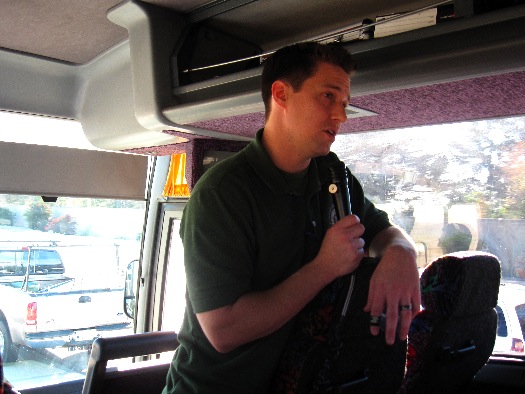
The bus trip began with a Firestone Walker presentation from Milstead, a self-professed “Southern California revolutionary.” Brother-in-laws Adam Firestone and David Walker started Firestone Walker Brewing Co. in 1996 on the grounds of the Firestone family’s now-sold winery. Milstead poured every bottle available from Firestone Walker and sister brand Nectar Ales, which two brothers started in Humboldt County and sold to Firestone about six years ago. The tasting progressed from lightest to darkest in terms of hops and alcohol, including Pale 31, an English pale ale brewed with Northwest hops; a Hemp Ale brewed with crushed hemp seeds; and Black Xantus, which is an 11% barrel-aged beer made with free-trade Mexican coffee and named for a rare Mexican hummingbird.
Milstead not only discussed Firestone Walker, he also fielded questions and cleared up misconceptions, including the idea that the beer’s color is indicative of strength. He even discussed gravity, a measure of fermentable sugars that are dropped into the wort to create alcohol; the more sugars, the higher potential for ABV. A number of prospective Surly Goaters asked Sweeney to classify specific beers, but he made it clear that “Beer is a spectrum,” not a group of categories.
We drove by the Miller plant on the 210 freeway and everybody booed. A couple people asked why everybody was booing the beer behemoth, and Milstead said it’s probably because MillerCoors brews using “adjuncts,” cheap additives like corn and rice that don’t improve flavor. If it’s not a core ingredient like water, malted barley, hops or yeast, it’s traditionally frowned upon. Then again, Sweeney pointed out that American craft brewers are tossing hundreds of different ingredients into the tanks, but they’re designed to improve flavor, so they’re more accepted.
Just before noon, we arrived at Stone Brewing Co., which occupies a 50,000 square foot facility in an Escondido industrial park. Press liaison Ken Wright led a tour of the glass-fronted brewhouse, which holds massive 12,000-gallon tanks.
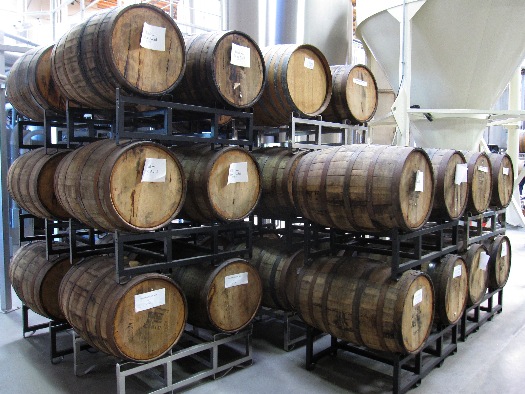
During our visit, Stone was brewing Old Guardian Barleywine, and the stack of Heaven Hill barrels was recently filled with Russian Imperial Stout. Wright explained that in California, if you age beer in whiskey barrels, it’s classified as a distilled product, so you need a distiller’s license to sell that beer. So far, they’ve used the oak barrels twice, and the more you use them, the more they mellow.
Wright distilled the brewing process into a few short sentences, saying: Boil water. Add sugar, since that’s where alcohol comes from. With quality beer, sugar comes from malted barley. Add hops for spice. Add the brew to tanks, add yeast and “that’s when the magic happens.” After two weeks, remove the brew, bottle and let the flavors meld.
Wright passed around a container of malted barley, which tastes like Grape Nuts. When toasted, the malt adds color and flavor to beer. Soaking and sprouting the barley expends sugars, creating alcohol.
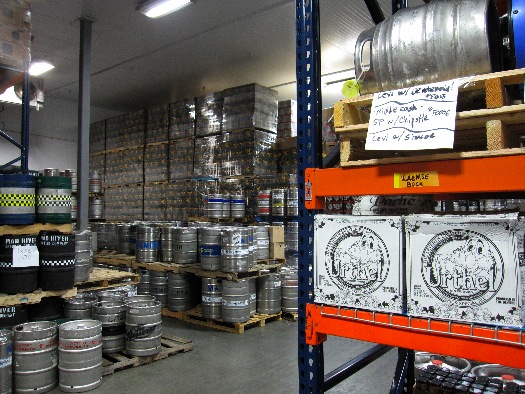
We walked past the bottling line and into an 8,000-square-foot cold storage room, which houses vintage Stone kegs, plus cases and kegs from breweries like Victory and Urthel, to name just two breweries. In addition to brewing beer, Stone is also one of Southern California’s top beer distributors. We learned that Stone plans to quadruple cold storage at a new building a mile away, clearing space for more fermenters.
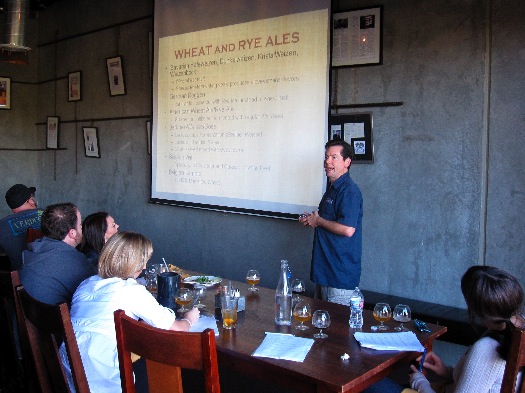
On the mezzanine of the Stone Bistro & World Gardens, we ate lunch and Wright made a Power Point presentation on beer’s history and two predominant styles: lagers and ales. He had some sage advice about beer in general, saying, “If the beer warms up and it tastes better, keep drinking. If it doesn’t, order something else.” He also discussed the first beer ever, a 7000-year-old Chinese brew containing wild grain and chrysanthemum. Dogfish Head brewmaster Sam Calagione recently brewed Chateau Jiahu using a variation on what archaeologists believe was original recipe. His history lesson eventually led to a discussion of ultra-hoppy IPAs. In San Diego County, which is where the hop arms race originated, brewers favor C Hops: Cascade, Chinook, Columbus and Centennial.
Wright led a six-beer tasting, including Victory Prima Pils, Sierra Nevada Pale Ale, Stone Smoked Porter, brewed with peat-smoked malt; Dupont Avec les Bons Voeux, a saison that smells like a barnyard; Heller Aecht Schlekerla Oak Smoke, a bacon-y Rauchbier made with peach wood-smoked malt; and Bockor Cuvee des Jacobins Rouge, a sour Flanders style red ale.
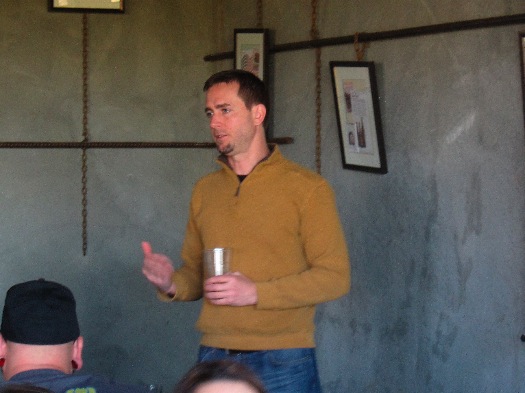
Stone CEO and co-founder Greg Koch made a speech, showing his appreciation for a crew who was committed to advancing craft beer’s cause. He referenced the longtime lack of L.A. bars with a commitment to craft beer, but expressed his satisfaction with the new guard. “You’re doing the heavy lifting for the noble work that we do,” said Koch. “How is the beer made? Who are the people behind it? What’s the philosophy? In the world of craft beer, there are real answers behind it.”

Our next stop was a San Marcos industrial park, the original home of Stone Brewing Co. Since March 2006, this building has housed The Lost Abbey, Port Brewing and the down-to-earth but legendary brewmaster who presides over both brands: Tomme Arthur.

He led a short tour of the brewery, which is probably best known for its barrel-aged and sour beers.
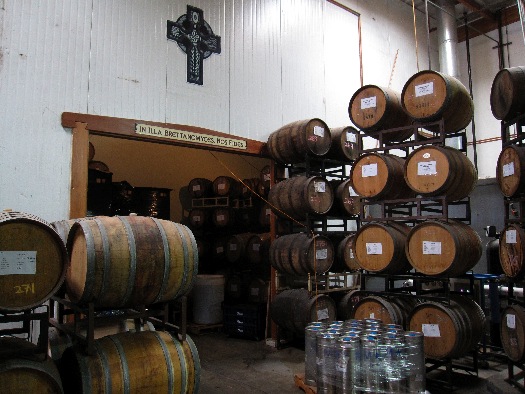
The barrels were stacked four-high and were featured prominently, but they only account for 5-10% of production. Arthur employs red wine oak barrels, Bourbon barrels and Brandy barrels. He said they’re “looking to reach the flavors of the barrels into the beer itself.” A sign hangs over the door to the barrel-aging room, reading “In Illa Brettanomyces, Nos Fides,” which translates to In These Wild Yeasts We Trust.
Combined, The Lost Abbey and Port Brewing Company produced 4000 barrels of beer in 2009, and now that the distribution center has moved to a building across the way in the business park, he’s targeting 6000 barrels in 2010, which is a small fraction of what a brewery like Stone is making.
The Stone stop was more structured. At The Lost Abbey/Port Brewing, it was more of a free for all, with Arthur and his brew crew pouring beers and available to answer questions. The focus was on staff bonding, with Verdugo Bar and Surly Goat staffers passing bottles and glasses, happy to share their discoveries.
The L-shaped bar faces a blackboard menu, a row of 24 taps and a wall of bottles topped with a cross, playing on The Lost Abbey’s Biblical themes. The barstools are pure simplicity, kegs topped with hop sacks.
On the way to Ballast Point Brewing, the bus driver missed the offramp and backed up until he could get back on the 15 South. That was awkward.

Ballast Point Brewing was a 1996 outgrowth of the Home Brew Mart, which Jack White founded in 1992. Ballast Point still uses the original location for Colby Chandler’s more experimental beers, but the bulk of the brewing is overseen by brewmaster Yuseff Cherney at the Scripps Ranch facility, which opened in 2005. We were greeted in the tasting room, which features tables topped with sawed-off beer barrels and plenty of fish imagery, made famous in the beer world by local artist Paul Elder.
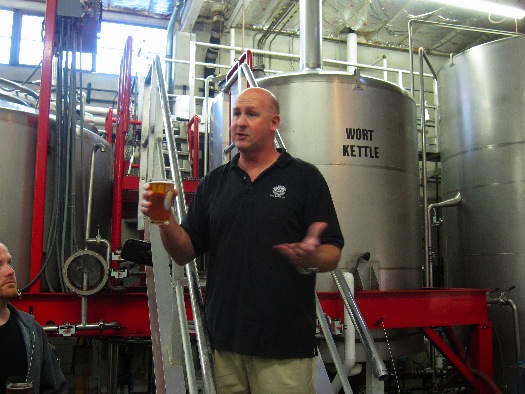
White explained that Ballast Point is named for a local landmark and that their beers are named for local deep-sea fish since Cherney is an avid fisherman.
White gave prospective Surly Goat staffers an overview of the fermenting line. The Mash-Lauder Tun is where water extracts sugar from malted barley. Spent grains are drained and later fed to local livestock. After that, wort enters the Wort Kettle. Then it’s cooled and moved into fermentation vessel. It takes a day’s work to get beer into the fermenting tanks. After that, it’s about temperature control and letting the yeast do its work.
After White explained the process, he took questions. Wes asked how they keep things fresh at the brewery. “We try to be innovative and creative, because that’s the fun part,” said White. “We’re always experimenting with barrel aging and new ingredients.”
Cherney briefly discussed the Ballast Point’s expansion into spirits, which he considers “advanced brewing” and “the next step in alchemy.” We saw cases of Old Grove Gin, and rum is on the way to market in February 2010.
After some more tasting and staff bonding, the beer-soaked crew boarded the bus for the return trip to Los Angeles. On the bus, when I asked Ryan if he was happy with how things went, he said, “It couldn’t have gone any better. Stone provided a good early base of education, and the rest of the time, everybody bonded, and it was organic.”
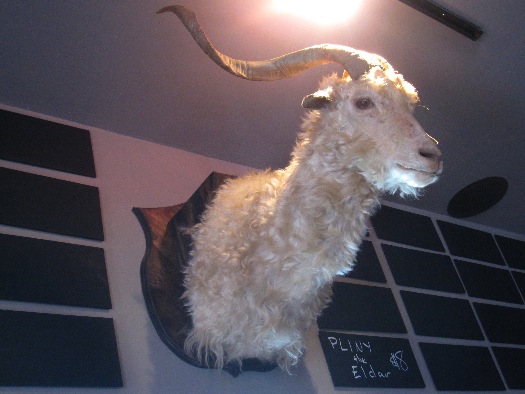
At this point, you’re probably interested in seeing photos of The Surly Goat. The neighborhood bar was undergoing some last minute construction during my visit last Friday, so clean sight lines were limited. Sweeney, Bradford and their crew stripped away the previous tenant’s garish gold.
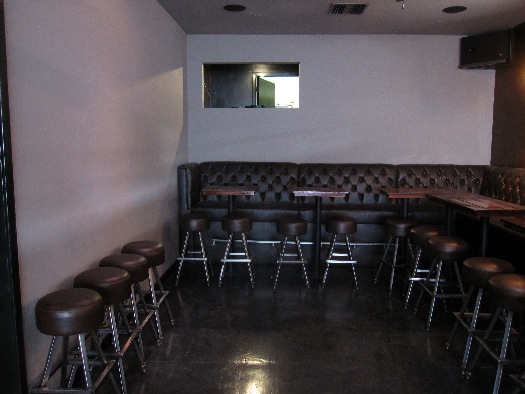
You’ll now find a half-oval black bar with a black satin finish and backlit steel base, chalkboard menu tiles flanking a goat head and teak tables crafted with wood pulled from the building’s facade.

Sweeney gobbled up goat-related beer posters, and they’ll line the walls, along with a goat mural courtesy of Thomas Lee Bakofsky.

The former VIP area has been turned into an elevated lounge. In back, you’ll find a tasting room, which is earmarked for private events. A walk-in cooler near the entrance holds 27 kegs, and there’s a single cask behind the bar. The bar houses three plasma screens, but only three since Sweeney believes “the whole point of a bar is to socialize.”

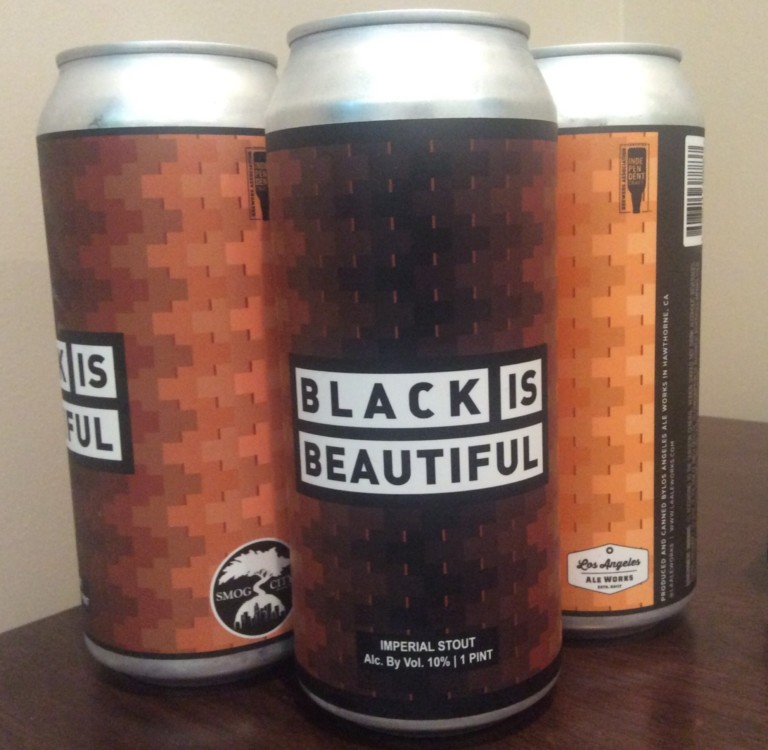
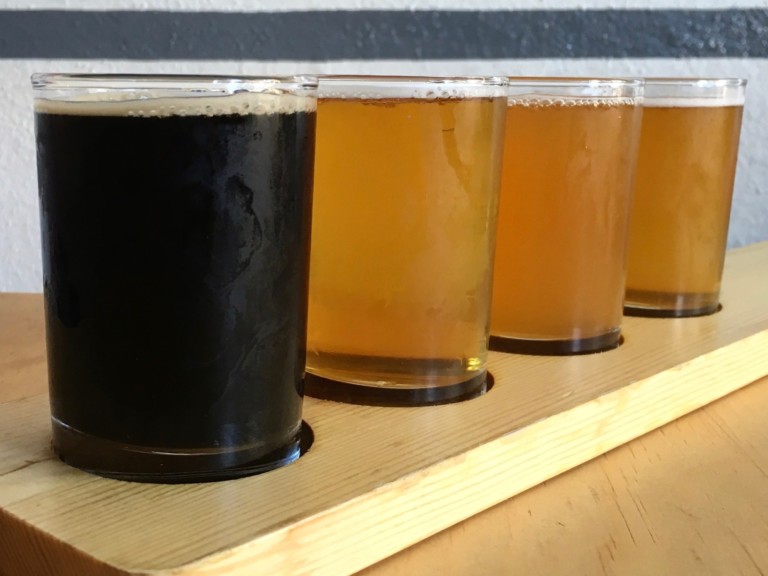
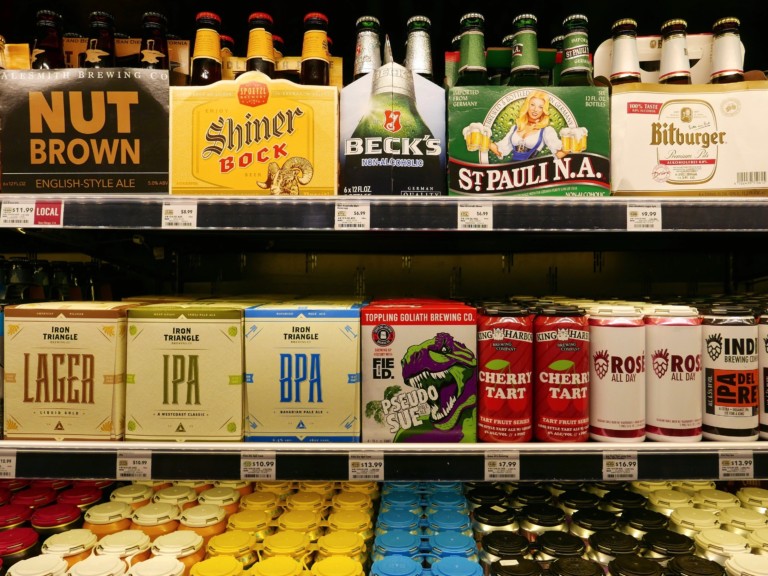




Blog Comments
Eats—Worker Confirms Spacecraft Space is Named ‘Goal,’ Progress at Capital Grille, Hola! Mexican Grill Closure, A Look at The Surly Goat, Hatfield’s Q&A, Daphne’s Greek Cafe Files Chapter 11 | Mondette
September 5, 2012 at 10:57 PM
[…] Surly Goat will be opening soon at 7929 Santa Monica Boulevard, just west of Fairfax. Food GPS tagged along with the owners and prospective employees on a day-long beer education and has some […]
Eats—Worker Confirms Spacecraft Space is Named ‘Goal,’ Progress at Capital Grille, Hola! Mexican Grill Closure, A Look at The Surly Goat, Hatfield’s Q&A, Daphne’s Greek Cafe File Chapter 11
January 19, 2010 at 12:53 PM
[…] Surly Goat will be opening soon at 7929 Santa Monica Boulevard, just west of Fairfax. Food GPS tagged along with the owners and prospective employees on a day-long beer education and has some […]
Are You Sick Of Bars Move The Tavern To Your House | Welcome medical oxygen nitrogen
January 19, 2010 at 4:45 AM
[…] The Surly Goat Primer […]
Food GPS » The Surly Goat Primer | Drakz bar Online Service
January 14, 2010 at 5:33 PM
[…] this link: Food GPS » The Surly Goat Primer Share and […]